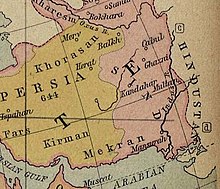Horasani

Horosani ose Horasani i Madh (persisht: خراسان Xorāsān/Xorâsân) është rajon që shtrihet në verilindje të Persisë (Irani të sotëm).[1] Në kohërat para-islame dhe islame, termi "Horasan" ka pasur kuptim më të gjërë, duke mbuluar edhe pjesë të Azisë Qendrore dhe Afganistanit; ndërsa në disa raste u përdori si term për çdo gjë në lindje të Persisë perëndimore.[2]
Etimologjia
[Redakto | Redakto nëpërmjet kodit]Emri "Horasan" rrjedh nga fjala e persishtes së mesme, gjuhë e folur në vitet 300–800, Khwarāsān (persishte e mesme: ![]() ), një fjalë e përbëre nga khwar (që do të thotë "diell") dhe āsān (nga fjala ājān, që do të thotë "të vijë"). Kështu fjala Horasan ose Horajan do të thotë "vendi ku ngritet dielli"[3] ose "lindja".[4] Fjala persiane Hāvar-zamīn (Persisht: خاور زمین) që do të thotë "vendi lindor", është përdorur si sinonim.[5]
), një fjalë e përbëre nga khwar (që do të thotë "diell") dhe āsān (nga fjala ājān, që do të thotë "të vijë"). Kështu fjala Horasan ose Horajan do të thotë "vendi ku ngritet dielli"[3] ose "lindja".[4] Fjala persiane Hāvar-zamīn (Persisht: خاور زمین) që do të thotë "vendi lindor", është përdorur si sinonim.[5]
Rëndësia kulturore
[Redakto | Redakto nëpërmjet kodit]Në të kaluar, Horasani i Madh kishte rëndësi kulturore në mesin e rajoneve tjera. Horasani mbetet rajon i kultures së Persisë. Shumë dijetarë vijnë nga Horasani, ata ishin Ahmed ibn Hanbeli, Imam Buhariu, Ebu Hanife, Imam Myslimi, Ebu Davudi, Imam Tirmidhiu, en-Nasa'i, El-Gazaliu, Imam Maturidiu, Imam Xhuvajni, Fahr ed-Din er-Raziu dhe të tjerë. Shejh Tusi, ez-Zamahshari dhe një dijetarë i shiave gjithashtu kanë jetuar në Horasan.
Referime
[Redakto | Redakto nëpërmjet kodit]- ^ "Khorasan". Encyclopædia Britannica Online. Marrë më 2010-10-21.
historical region and realm comprising a vast territory now lying in northeastern Iran, southern Turkmenistan, and northern Afghanistan. The historical region extended, along the north, from the Amu Darya (Oxus River) westward to the Caspian Sea and, along the south, from the fringes of the central Iranian deserts eastward to the mountains of central Afghanistan. Arab geographers even spoke of its extending to the boundaries of India.
((cite web)): Mungon ose është bosh parametri|language=(Ndihmë!) - ^ "Khurasan", The Encyclopaedia of Islam, page 55. Brill. Marrë më 2010-10-22.
((cite book)): Mungon ose është bosh parametri|language=(Ndihmë!) - ^ Humbach, Helmut, and Djelani Davari, "Nāmé Xorāsān" Arkivuar 2 janar 2011 tek Wayback Machine, Johannes Gutenberg-Universität Mainz; Persian translation by Djelani Davari, published in Iranian Languages Studies Website
- ^ MacKenzie, D. (1971). A concise Pahlavi dictionary (p. 95). London: Oxford University Press.
- ^ DehKhoda, "Lughat Nameh DehKhoda" Arkivuar 18 korrik 2011 tek Wayback Machine, Online version
Text is available under the CC BY-SA 4.0 license; additional terms may apply.
Images, videos and audio are available under their respective licenses.
